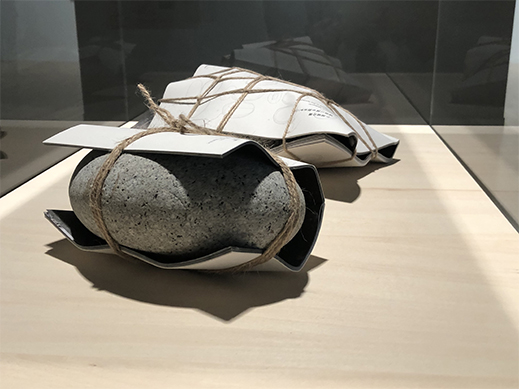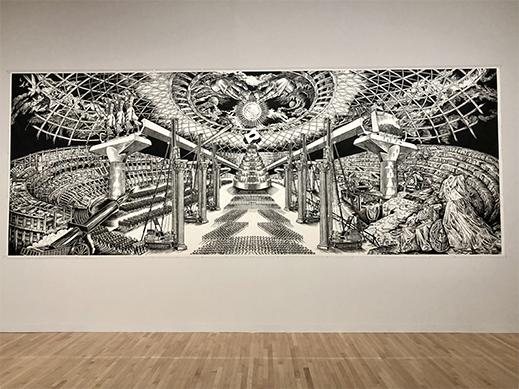 |
Focus features two in-depth reviews each month of fine art, architecture, and design exhibitions at art museums, galleries, and alternative spaces around Japan. |
|
|
 |
 |
 |
Where Are We Now? Motoyuki Shitamichi and Sachiko Kazama's TCAA Exhibition
Jennifer Pastore |
 |
Sachiko Kazama, Prison Nuke Fission (2012) |
Motoyuki Shitamichi and Sachiko Kazama are the winners of the inaugural Tokyo Contemporary Art Award (TCAA), established to help mid-career artists make breakthroughs in their practice. Along with prize money and a stipend for work abroad, they have been granted an exhibition at the Museum of Contemporary Art Tokyo (MOT). According to the selection committee, multimedia artist Shitamichi and printmaker Kazama were chosen for the award because they both "have strong practices and are at a moment in their work where the possibility of time spent abroad can be very fruitful." The MOT exhibition, which features early and recent works from both artists, is free of charge and has been extended through 22 June (open every day from 1 June). Online reservations are required.
Installation view of Motoyuki Shitamichi's section of the exhibition, with Tsunami Boulder (2015-) in the background
|
Shitamichi, who travelled to northeast China and Venice on the TCAA stipend, remarks about his practice: "A landscape, history, people -- I encounter them, arrange them a bit, photograph them, and the work gradually takes shape." His projects have an ethnological bent, as seen in his Torii series of photographs of the traditionally orange Shinto gates found around the world as relics of Japanese colonialism. The current exhibition spotlights his interest in intersections of the environmental and the societal. Tsunami Boulder, part of Shitamichi's long-term project Floating Monuments, is presented as a grid of nine videos showing boulders that have been washed ashore by tsunamis, taking on newfound significance. Some host trees and birds, others have become worshipped deities.
For the project 14 years old & the world & borders, Shitamichi interviewed 14-year-olds in Asia and France, asking for their perspectives on "the boundaries around you." Their responses, published in local newspapers and compiled in a book, are presented in the exhibition along with major headlines from the press. One display juxtaposes a newspaper that shows the South Korean leader meeting the pope with a submission from a Japanese teenager that reads "One day, the black ships of Commodore Perry will come and demand that I open up. When they come, things will become busy. That's why I'm enjoying the peace and quiet of isolation for now." A note with the text mentions that the farthest place the student has traveled is Osaka.
 |
|
Motoyuki Shitamichi, New Stone Tools (2015, 2017)
|
Shitamichi's series New Stone Tools is represented by an arrangement of round, head-sized rocks wrapped in paper and rope. The project was inspired by the landscape of a fishing village in Kurobe, Toyama Prefecture, where the artist held an exhibition. Stone tools have been excavated from ancient pit houses in the area. Shitamichi observes that these primitive objects retain their practicality today, with uses ranging from doorstops to construction and gardening to pickling. Bundled together with booklets reading "Open yourself to the landscape," these stones allude to the primeval tendencies within all of us.
Motoyuki Shitamichi, Floating Monuments (2014-)
|
Okinawan Glass is another component of Shitamichi's Floating Monuments series. The project began when he found glass bottles on Okinawan beaches while photographing for Tsunami Boulder. He arranged for the bottles, which drifted ashore from other countries, to be washed, crushed, melted, and transformed into Ryukyu glass, a craft that developed in Okinawa during the U.S. occupation with the recycling of soda and beer bottles discarded by American soldiers. Shitamichi's transparent green glass takes the form of vases and bottles displayed on top of a map showing Okinawa, Taiwan, and China.
Motoyuki Shitamichi, Remnants (2001-2005)
|
The final section of the exhibition presents early works by Shitamichi and Kazama. Shitamichi's display features prints from his Remnants series depicting sites of former military facilities across Japan. These shots of what appear to have become mostly farm plots recall the work of Tomoko Yoneda, who also documents locations with military history. Furthermore, they offer an early glimpse of Shitamichi's long-running interest in fieldwork and themes of place.
Sachiko Kazama, Der Zauberberg (2021) |
Embodying an ethos of "Sturm und Drang" in her work, Sachiko Kazama is known for elaborate, often enormous woodblock prints that pack a satirical punch. She has taken on Japanese political themes such as militarism, statecraft, and nuclear power. For her TCAA stint, she chose to focus on the German author Thomas Mann's 1924 novel Der Zauberberg (The Magic Mountain), producing prints inspired by themes and scenes in the book. Much of the story takes place at a sanatorium in the Swiss mountains, where the protagonist is treated for tuberculosis before being sent off to fight in World War I.
From left to right: Sachiko Kazama, Der Lungenwald - Primitive Vein (2021), Der Lungenwald - Xmas Truce (2021), and Der Lungenwald - Lindenbaum (2021)
|
The print Der Zauberberg shows a water-reflected landscape of imposing peaks, presumably the Magic Mountain range itself. Like all of Kazama's works, it is in black and white. (She has stated that she opts for monochrome because black does not give a sense of age.) Motifs of mountains and lungs appear in several of the works, such as Der Lungenwald - Lindenbaum, which shows a tree branching out into bronchiole-like limbs. Themes of war are also commonly depicted -- Der Lungenwald - Xmas Truce portrays soldiers communing under a fir tree while tanks rumble around them.
Kazama had intended to use her TCAA stipend to spend time in Berlin researching Nazi history, but like the Magic Mountain protagonist, her plans were interrupted by disease when the coronavirus crisis shut down travel. About her interest in Germany, she explains, "I want my Dyslympics 2680 to be paired with the original dyslympics, the Berlin Dyslympics." This seminal work of Kazama's, originally featured in a 2018 exhibition at the Maruki Gallery for the Hiroshima Panels, is on display in this show. Envisioning an Olympics-fueled authoritarian nightmare, Dyslympics 2680 is one of several Japan-focused works that illustrate Kazama's worldview.
 |
|
Sachiko Kazama, Dyslympics 2680 (2018) |
While vastly different in their methods and styles, Shitamichi and Kazama share an interest in the underlying memories and histories of places. They both investigate how we got to where we are now, and allude to where we might be headed in the future. Kazama has stated that she works in the print medium because it is "a form that is extremely easy to leave to the next generation." Perhaps one day, this exhibition will serve as a kind of archeological evidence for people wondering about the year 2021 and how we ended up where we are.
Bilingual (Japanese and English) monographs about the exhibition can be downloaded for free from the TCAA website, which also features interviews with the artists. There are further plans to post an artists' talk, interpreted into English, on the Tokyo Arts and Space YouTube channel. These supplementary materials offer a thorough and insightful look at the show for both those who have seen it and those who cannot attend.
All photographs by Jennifer Pastore, courtesy of the Museum of Contemporary Art Tokyo. |
 |
 |
Jennifer Pastore
Jennifer Pastore is a Tokyo-based art fan and translator. In addition to Artscape Japan, her words have appeared in ArtAsia Pacific, Sotheby's, and other publications. She is an editor at Tokyo Art Beat. |
|
 |
|